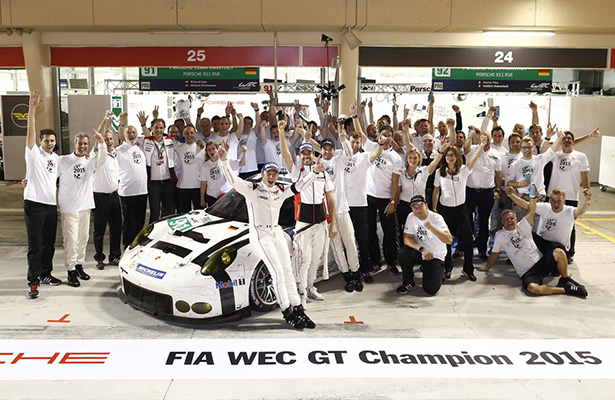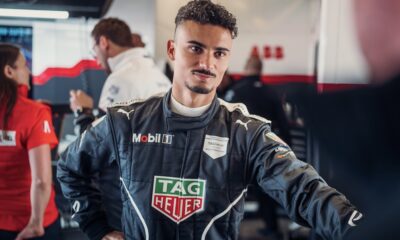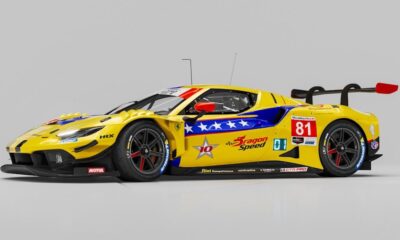
Photo: Porsche
With a sweep of the GT titles in both the FIA World Endurance Championship and IMSA TUDOR United SportsCar Championship seasons, not to mention its historic 1-2 overall finish at Le Mans and LMP1 world titles, 2015 will be looked back as the year of Porsche.
The German manufacturer dominated the sports car scene, particularly in the second half of the season, with its factory-run Porsche 911 RSRs coming to life in both IMSA and WEC competition.
For Dr. Frank-Steffen Walliser, Head of Porsche Motorsport, who directed the winning global efforts, it will be a year he’ll never forget.
“Honestly, at the beginning of the season we would not have been in a position to be so strong,” Walliser told Sporscar365.
“We developed a lot of things over the year, we improved, we changed things in the team. We changed the driver lineup. A lot of measures were taken. But you can never be sure if everything plays out and works.
“It was a little bit of luck, finally, for sure. But it was definitely a dream year.”
Porsche’s year started off in the worst possible way at the Rolex 24, when contact between Earl Bamber and Marc Lieb saw both Porsche North America entries eliminated from contention for repeat GTLM class honors.
Remarkably, it took until the fourth round of the TUDOR Championship season at Mazda Raceway Laguna Seca for either of the Nos. 911 or 912 car to reach the podium for the first time.
“It started in Daytona,” Walliser said. “When you see both cars crashing, you hear it on the radio and you can’t believe it.
“[Another moment] was definitely Le Mans, after an hour seeing the engine exploding was not so nice.
“But Le Mans had been a turning point for our whole racing operations in GT. We sat down, I talked to the people.
“Everybody remembers my speech still. It was a very German style. There was no talking around. But people remember and there was something of a turnaround.”
Walliser said changes in the two teams helped reinvigorate their title pursuits, with drivers Nick Tandy and Earl Bamber also back from their LMP1 victory at Le Mans and focused 100 percent on the GT efforts.
“It’s not the action of a single person, just everybody improved,” he said. “Including the drivers, the teams, the mechanics, engineers.
“Everybody jumped in and tried to improve everything. That was the breakthrough.”
Mosport kicked off a string of three consecutive GTLM victories for Tandy and Patrick Pilet, while in the WEC, the Porsche Team Manthey paring of Richard Lietz and Michael Christensen broke through for their first win of the season on home ground at the Nürburgring.
“I think the Nurburgring was a big one for the WEC [program],” Walliser said. “It was the home race and first victory after this difficult period in WEC. It was a big moment for us as a family.”
It was followed up by GTE-Pro class victory at Circuit of The Americas and a pivotal win in the wet at in the penultimate WEC round of the season in Shanghai, which put Lietz in prime position to take the drivers’ title in Bahrain.
One month earlier, the Austrian supported Pilet and Tandy’s historic run to the overall win at Petit Le Mans, in the shortened rain-soaked IMSA finale that also saw Pilet clinch the GTLM drivers’ title.
For Walliser, Petit Le Mans proved to be one of his most memorable moments of year.
“Road Atlanta was one of those as it was so surprising with the overall win,” he said. “Every minute [at Pettit Le Mans] it was unclear what would happen.”
While the Porsche 911 RSR received Balance of Performance adjustments mid-season in both series, Walliser said another big step forward came with tire development.
Michelin rolled out with new tires for the rear-engined car, with the IMSA “Single-Stinters” debuting at Road America, that arguably contributed to two of the No. 911 car’s class victories.
“We benefitted but it was clear that Michelin played it very open,” Walliser said. “For sure we tested it and took the advantage.
“If something like this comes by, you take it and win.”
While the history books show Porsche having claimed the GT drivers’, teams’ and manufacturers’ titles in both WEC and IMSA, Walliser said they were achieved in very different ways.
“It’s different,” he said. “In the U.S., with the racing with the yellows and safety cars, if you make a mistake, you can come back.
“If you lose Daytona, it’s not double points or something like that. That’s why you have a better chance to stay longer in the championship.
“The other side, you can never make a big advantage, so it was still open until the last race. Maybe the advantage we had this season was that we had enough rain.
“We had two races in the U.S. and two in WEC in rainy conditions, and for the 911, it’s not bad.”
Luck, no doubt, played a factor as well in the success, but it will be tough for any manufacturer to repeat the level of success the brand from Weissach achieved globally in factory competition this year.






















